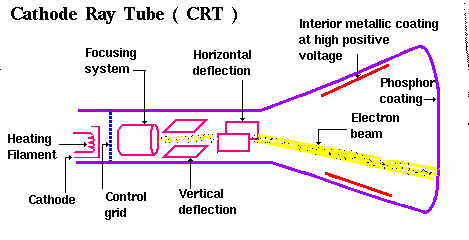There are several applications of CRO, namely:
1. Measuring the potential difference of a d.c.supply
2. Measuring the potential difference of an a.c. supply
3. Measuring a short duration of time
4. Measuring wave frequency
5. Displaying different wave forms
DEDICATED TO HELP STUDENTS EXCEL IN PHYSICS BY GIVING NOTES, MOTIVATION AND RESOURCES ESPECIALLY FOR (O-LEVEL), High School, Secondary School Students. Grade 9 | Grade 10 | Year 9 | Year 10 | Form 4 | Form 5| | This site is best seen using Web version. If this site helps, please consider sharing this in your social media. Thanks heaps! |
2019-08-18
How energy of electrons is converted in Cathode ray tube
Below are samples of Cathode ray tube diagram

Reference: https://www.semanticscholar.org/paper/Simulation-of-cathode-ray-tube-Maiti-Rajagopal/ca0d214bf66cd8a3f01d175e0455dcc37deb71f4/figure/0

Reference: https://www.javatpoint.com/fullformpages/images/crt.gif
As electric current pass through the filament, it heats up and emits electron. This means electrical energy is converted to heat energy. The difference in electrical energy potential from anode and cathode increases the acceleration of electrons towards the fluorescent screen. This means electrical potential energy is converted kinetic energy of electrons. The high speed electrons then smash the screen and produce flourescence (light).
So that means electrical potential energy = kinetic energy
eV = 1/2 mv^2
electron charge, e = 1.6 x 10 ^ -19 C
electron mass, m = 9.1 x 10 ^ -31 kg
v = final velocity of electron
v^2 = 2eV/m
Example of question:
KE = 1.2eV

Reference: https://images.slideplayer.com/39/10862668/slides/slide_5.jpg

Reference: https://www.semanticscholar.org/paper/Simulation-of-cathode-ray-tube-Maiti-Rajagopal/ca0d214bf66cd8a3f01d175e0455dcc37deb71f4/figure/0

Reference: https://www.javatpoint.com/fullformpages/images/crt.gif
As electric current pass through the filament, it heats up and emits electron. This means electrical energy is converted to heat energy. The difference in electrical energy potential from anode and cathode increases the acceleration of electrons towards the fluorescent screen. This means electrical potential energy is converted kinetic energy of electrons. The high speed electrons then smash the screen and produce flourescence (light).
So that means electrical potential energy = kinetic energy
eV = 1/2 mv^2
electron charge, e = 1.6 x 10 ^ -19 C
electron mass, m = 9.1 x 10 ^ -31 kg
v = final velocity of electron
v^2 = 2eV/m
Example of question:
KE = 1.2eV

Reference: https://images.slideplayer.com/39/10862668/slides/slide_5.jpg
Subscribe to:
Posts (Atom)